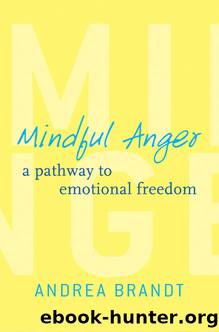Mindful Anger: A Pathway to Emotional Freedom by Andrea Brandt

Author:Andrea Brandt [Brandt, Andrea]
Language: eng
Format: epub
Publisher: W. W. Norton & Company
Published: 2014-03-30T22:00:00+00:00
CHAPTER 8
The Five Steps to Mindfully Releasing Your Anger
Long-suppressed anger may lie so deep youâre not aware of it in your everyday life. Worried about periodic episodes of anger, you may explore your present circumstances and the feelings it evokes and still feel an underlying anger. These are fears and hurts and emotions that began in childhood. You can reach these emotions and release them so that you can move on to a more fruitful life, but it will take additional work. This chapter describes a strategy that has worked for many people.
As weâve seen, our thoughts, feelings, and memories from past events and traumas that were not fully experienced remain unprocessed and lead to energy being blocked or trapped in the body. We then feel this blocked energy as tightness, tension, or pain. Typically, anger gets deposited in the upper back, shoulders, and neck; sadness in the upper chest and throat; and fear in the intestines and stomach. To free ourselves from the memories of these traumas and events, the associated emotionsâstored deep within on an unconscious cellular levelâneed to be released.
STEP 1: GET YOUR ANGER PERCOLATING
The first step to moving old anger up and out is to awaken itâget it bubbling and stirring inside you, much the way coffee percolates inside an old-fashioned coffee maker. In the Starbucks era, weâve lost track of the way our grandparents usually made coffee. They would fill a special pot or percolator with water and then insert a basket on a tube, which held the coffee grounds. As the water boiled, it bubbled up through the tube, filtering back into the pot through the coffee grounds. This would go on for several minutes until the coffee was brewed. In the same way, you can let your anger percolate through your consciousness until old memories and feelings emerge.
Breath work, one of the key tools of mindfulness, helps us accomplish thisâitâs the boiling water in our emotional percolation. Breath work awakens the cells and activates the bodyâs own natural healing power to complete and integrate repressed experiences and release the energy in blocked or stagnant areas. If these feelingsâthe coffee groundsâstay stuck in our bodies, they can set the stage for a number of physical disorders. Slow, deep breathing also provides important health benefits. It both stimulates the immune system and relaxes the nervous system. Deep breaths help the lungs and blood vessels function better. Other benefits include lowering blood pressure, reducing anxiety and mild depression, and decreasing symptoms of asthma. Some forms of breath work can help relieve pain, increase energy, and reduce hot flashes.
Through focusing your attention on the breath, mindfulness also keeps you in the nowâin your bodyârelaxing you and helping you tune in to the sensations, emotions, and other internal activities that tell you what is going on with you. Mindful breathing is one of the best ways to get in touch with your inner world and begin to hear its messages about your real experiencesâshowing you where you need to process out feelings and integrate new learning for a happier, healthier state of mind.
Download
This site does not store any files on its server. We only index and link to content provided by other sites. Please contact the content providers to delete copyright contents if any and email us, we'll remove relevant links or contents immediately.
Professional Troublemaker by Luvvie Ajayi Jones(29417)
Whiskey Words & a Shovel I by r.h. Sin(19187)
Rewire Your Anxious Brain by Catherine M. Pittman(18288)
Healthy Aging For Dummies by Brent Agin & Sharon Perkins RN(16919)
Cat's cradle by Kurt Vonnegut(14757)
Talking to Strangers by Malcolm Gladwell(12865)
The Art of Thinking Clearly by Rolf Dobelli(9908)
They Both Die at the End by Adam Silvera(9480)
The 5 Love Languages: The Secret to Love That Lasts by Gary Chapman(9273)
Doing It: Let's Talk About Sex... by Hannah Witton(9074)
The Compound Effect by Darren Hardy(8504)
Thirteen Reasons Why by Jay Asher(8449)
Goodbye, Things by Fumio Sasaki(8287)
Wonder by R.J. Palacio(8265)
Atomic Habits: Tiny Changes, Remarkable Results by James Clear(8043)
Becoming Supernatural by Dr. Joe Dispenza(7831)
Tools of Titans by Timothy Ferriss(7807)
Wonder by R. J. Palacio(7736)
Should I Stay or Should I Go? by Ramani Durvasula(7427)
